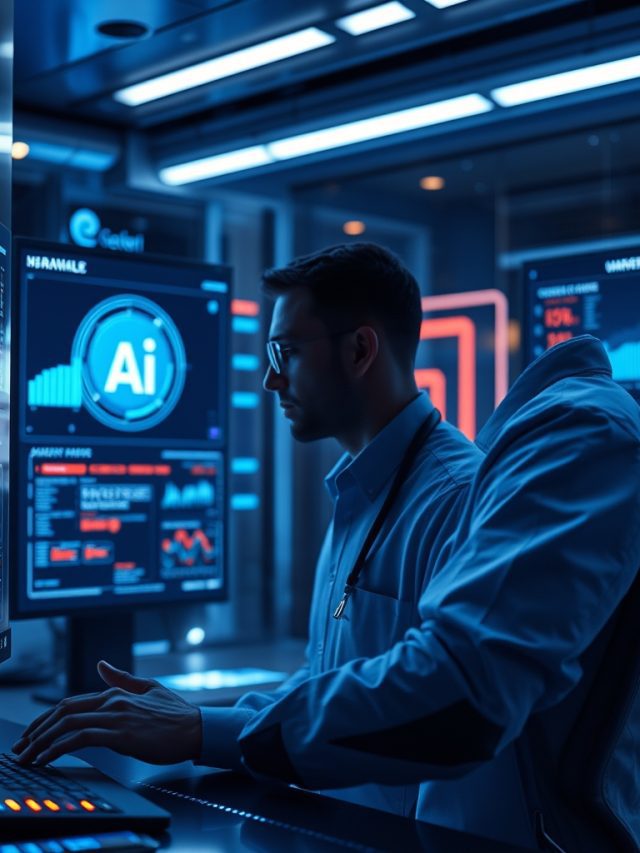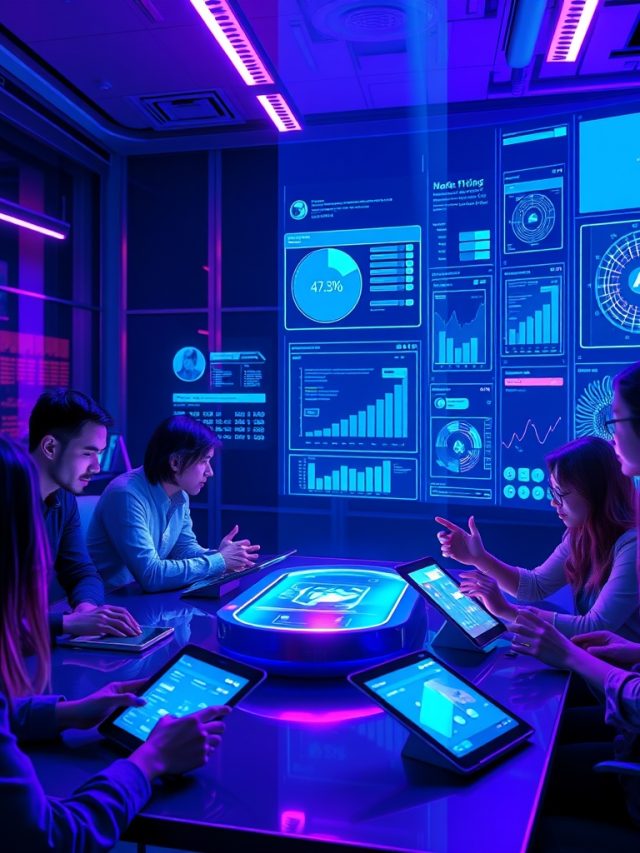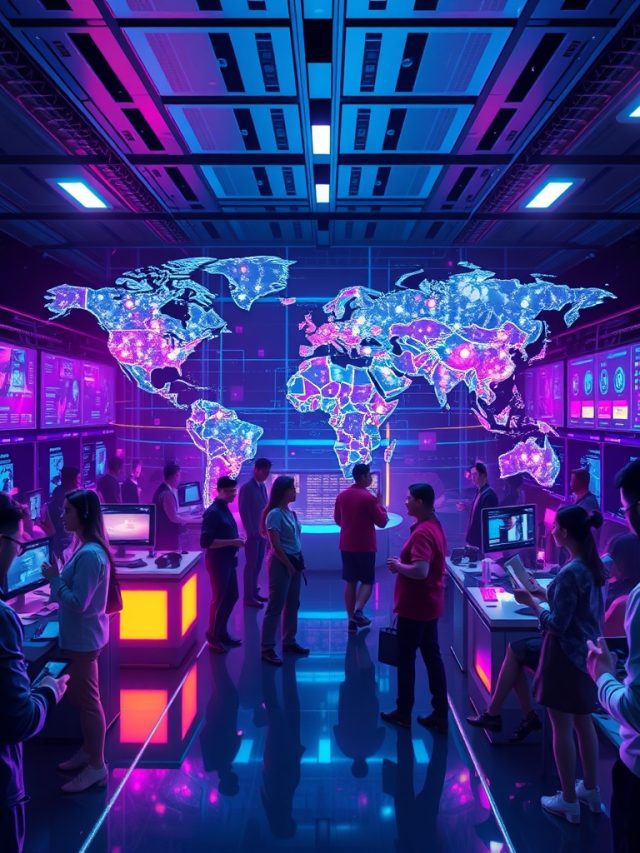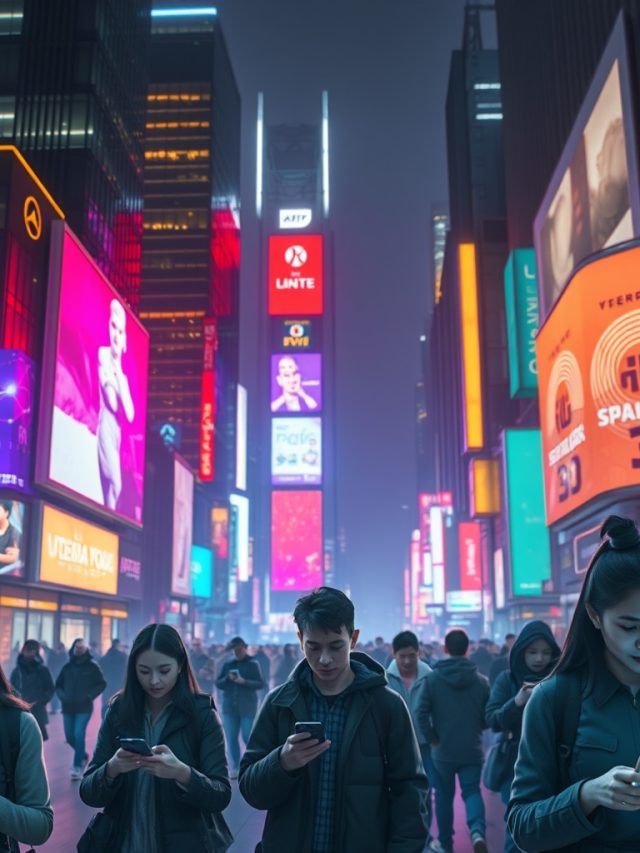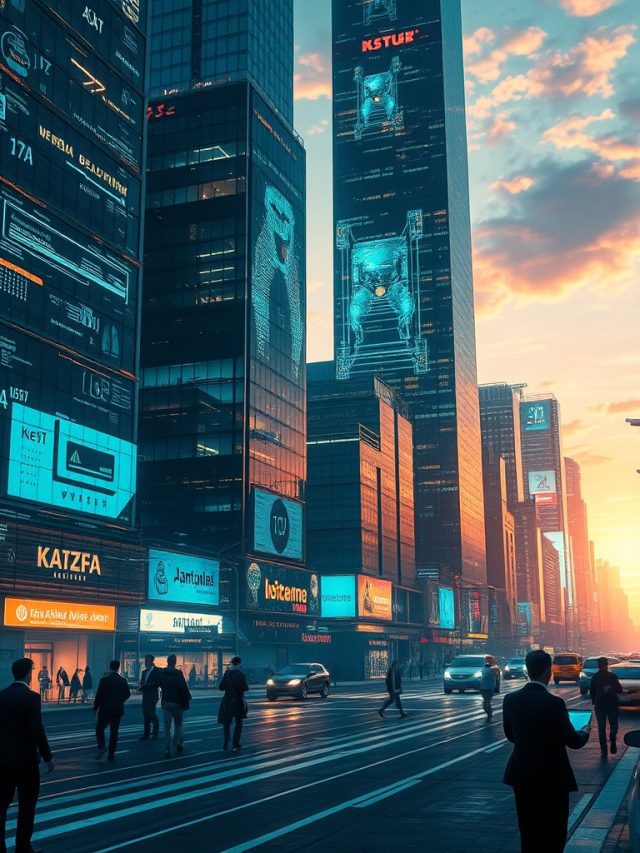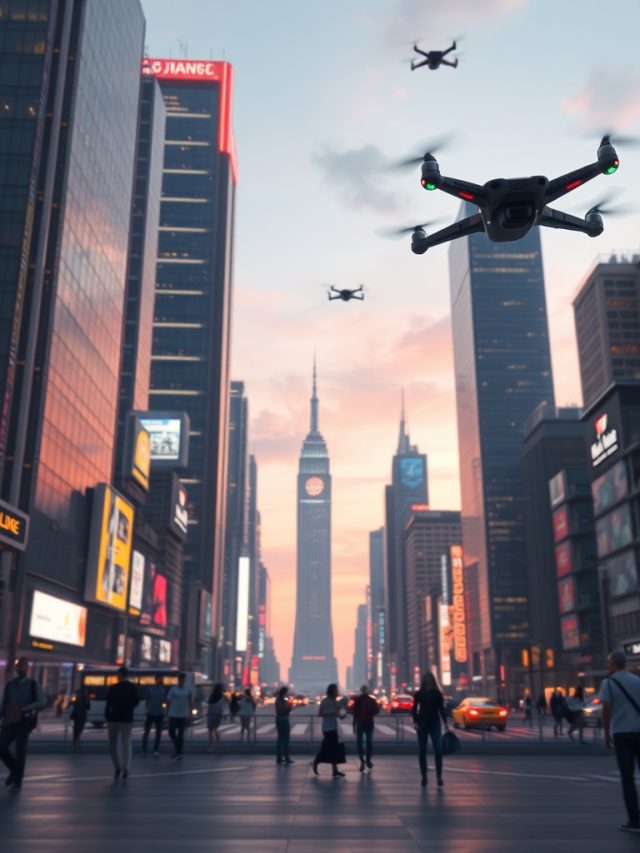Artificial intelligence is no longer a futuristic concept—it’s a present-day reality reshaping industries and redefining what it means to work. From marketing automation to software development, AI programming is sparking one of the most significant shifts in the U.S. job market since the dawn of the internet. The rapid advancement of AI technologies has ignited a critical and often heated debate: Is AI a job creator or a job destroyer?
Table of Contents
A landmark 2023 Goldman Sachs AI report brought this question into sharp focus, estimating that generative AI could impact 300 million full-time jobs globally. For the United States, this translates to roughly two-thirds of all occupations being exposed to some degree of AI automation. This statistic can be alarming, but it doesn’t tell the whole story.

The narrative emerging from deep analysis is not one of simple replacement, but of a profound transformation. The integration of AI is leading to a massive shift from routine, repetitive tasks to new roles that leverage uniquely human skills like creativity, strategic thinking, and emotional intelligence in partnership with intelligent systems. This guide will provide a deeply researched look into how does AI impact jobs, analyzing the data, identifying the specific AI job opportunities emerging, detailing the in-demand AI skills you need, and offering actionable advice to future-proof your career in this new era.

The Great Disruption: Understanding AI’s Impact on the U.S. Job Market
To understand the current shift, it’s crucial to recognize that AI programming is fundamentally different from the automation of the past. It represents a new paradigm in how we interact with technology.
More Than Automation: How AI Programming Differs
Traditional programming involves a developer writing explicit, step-by-step instructions for a computer to follow. If you want a program to perform a task, you have to code every single rule and contingency.
AI programming, particularly in the realm of machine learning, is different. It involves creating models that can learn from data to recognize patterns, make predictions, and perform tasks without being explicitly programmed for every single scenario. This ability to learn and adapt is what makes AI so powerful and disruptive to the AI job market U.S.

The Scale of the Shift (Data-Driven)
While the Goldman Sachs figure of 300 million impacted jobs is staggering, it’s essential to look at the other side of the equation. The World Economic Forum’s “Future of Jobs Report 2023” projects a net positive outcome for the global workforce. While it estimates that 85 million jobs may be displaced by 2025, it also forecasts that 97 million new roles could emerge during that same period.
This highlights the core theme of the current AI revolution: it’s less about mass unemployment and more about a massive skills shift. Furthermore, this transformation is expected to create enormous economic value. The same Goldman Sachs report predicts that widespread AI adoption could eventually boost the annual global GDP by a staggering 7%.
Augmentation, Not Replacement: The New Human-AI Partnership
For most professionals, especially in white-collar fields like digital marketing and tech, the most immediate impact of AI is not replacement but augmentation. AI is rapidly becoming the most powerful tool in the modern professional’s toolkit, acting as a highly efficient coworker that can handle the tedious work, allowing humans to focus on higher-value tasks.
How AI is Becoming Your Most Productive Coworker
The core concept is that AI excels at tasks that are data-intensive, repetitive, and analytical, while humans excel at strategy, creativity, and empathy. The future of work lies in combining these strengths.
Instance: An AI will not replace a skilled digital marketer. Instead, it will supercharge them. An AI-powered tool can analyze vast datasets to identify target audiences, predict campaign performance, and optimize ad spend in seconds. This frees up the human marketer to focus on the truly impactful work: developing creative strategy, building a compelling brand narrative, interpreting the AI’s findings, and making executive decisions.
Proof from the Tech World: GitHub Copilot
One of the clearest examples of this augmentation effect comes from the world of software development.
GitHub Copilot, an AI tool developed in partnership with OpenAI, acts as a “pair programmer” for developers. It suggests entire lines or blocks of code, automates the creation of repetitive functions, and helps debug errors in real-time. It doesn’t replace the developer; it makes them faster and more efficient.
The data on this is striking. A groundbreaking MIT study provided clear evidence of this powerful AI augmenting human workers. The study found that developers who used an AI assistant like Copilot completed their assigned tasks an incredible 55.8% faster than those who did not.

The Evolving Workforce: Jobs of the Future vs. Jobs at Risk
The shift driven by AI programming is creating clear winners and losers in the job market. The roles most at risk are those that are highly predictable and based on routine data processing or manual tasks. Conversely, the new jobs created by AI are those that are focused on building, managing, and leveraging these new intelligent systems.
Jobs Most Exposed to Automation
The roles most susceptible to being impacted by AI are those characterized by structured and repetitive tasks. These include:
- Office & Administrative Support: Jobs like data entry clerks, receptionists, and executive assistants involve tasks that AI can automate with high efficiency.
- Customer Service: Basic customer inquiries and support are increasingly being handled by sophisticated AI chatbots.
- Paralegals & Legal Assistants: AI can now review and summarize vast legal documents much faster than humans.
- Entry-Level Accounting: Tasks like bookkeeping and data reconciliation are prime candidates for automation.
New and Emerging Jobs Created by AI
The AI job market U.S. is booming with new, high-demand roles that didn’t exist a decade ago. The WEF places AI/Machine Learning Specialists at the top of its list of fastest-growing jobs. Other emerging roles include:
- Prompt Engineers: Experts in crafting the perfect questions and instructions to get the most accurate and creative output from generative AI models like GPT-4. This is a brand new and highly sought-after skill.
- AI Ethics Officers: As businesses increasingly rely on AI, there is a growing need for professionals who can ensure these systems are fair, transparent, and free of bias.
- AI Product Managers: These individuals guide the development of AI-powered products and features, bridging the gap between technical teams and business goals.
- Data Annotators: The human workforce behind the curtain, responsible for labeling images, text, and other data to train and fine-tune machine learning models.

The table below details how AI is transforming existing roles, requiring professionals to adapt and evolve.
| Job Category | How AI is Augmenting the Role | New Skills Required |
| Digital Marketer | AI automates A/B testing, audience segmentation, content idea generation, and performance analytics. | High-level marketing strategy, creative direction, brand building, data interpretation, and Prompt Engineer skills for content creation. |
| Software Developer | AI handles boilerplate code, suggests functions, and assists with real-time debugging (e.g., GitHub Copilot). | Complex system architecture, advanced problem-solving, AI model integration, and cloud computing expertise. |
| Graphic Designer | Generative AI tools (e.g., Midjourney) create visual concepts, generate assets, and suggest layouts. | Creative direction, image curation, advanced editing and post-production, brand consistency, and expert prompting. |
| Financial Analyst | AI processes vast amounts of market data, detects fraud, and identifies trading anomalies in real-time. | Strategic financial advisory, complex risk modeling, client relationship management, and interpreting AI-driven insights. |
| Healthcare Professional | AI analyzes medical scans (X-rays, MRIs) and patient data to assist in early disease detection. | Final diagnosis, patient care and empathy, complex treatment planning, and using AI as a diagnostic aid. |
The AI Skills Playbook for 2025 and Beyond
To succeed in the rapidly evolving AI job market U.S., professionals need to cultivate a blend of cutting-edge technical skills and timeless human abilities.
The Technical Toolkit: In-Demand AI Skills
The demand for technical AI talent is exploding. To get one of the many AI programming job opportunities, you need to master the right tools.
- Programming Languages: Python for AI is the undisputed king. Its simplicity and, more importantly, its vast ecosystem of libraries make it the go-to language for machine learning and data science. R is also popular for statistical analysis, while Java and C++ are used in larger, enterprise-level AI applications.
- AI/ML Frameworks & Libraries: Proficiency in these is a must for any aspiring AI professional. The industry standards include:
- TensorFlow: Developed by Google, a powerful open-source library for deep learning.
- PyTorch: Developed by Facebook, known for its flexibility and ease of use in research and development.
- scikit-learn: An essential Python library for traditional machine learning algorithms.
- Keras: A high-level API that makes building and testing neural networks simpler.
- Core Concepts: A deep understanding of areas like Natural Language Processing (NLP), Computer Vision, Deep Learning, and Reinforcement Learning is what separates a novice from an expert.
The Salary Incentive
The high demand for these specialized skills is directly reflected in compensation.

Instance: According to data from Glassdoor and Levels.fyi, the average AI engineer salary U.S. ranges from $120,000 to $150,000 per year. Senior roles at major tech firms like Google, Microsoft, and Amazon can command salaries well over $200,000, along with significant stock options.
The Irreplaceable Human Skills
As AI takes over more of the routine technical tasks, uniquely human skills are becoming more valuable, not less. The future of work AI is a collaboration, and these skills are what humans bring to the table.
- Critical Thinking & Complex Problem-Solving
- Creativity & Innovation
- Emotional Intelligence & Communication
- Strategic Decision-Making
- Leadership & Collaboration
Future-Proofing Your Career in the Age of AI
The single biggest threat to any professional’s career is not AI itself, but the failure to adapt to it. The key to thriving in the coming decade is to embrace a mindset of continuous, lifelong learning.
The Upskilling Imperative
The days of learning a skill and coasting on it for an entire career are over. The pace of change in the AI job market U.S. demands constant upskilling for AI.
- Online Courses & Certifications: The barrier to learning in-demand AI skills has never been lower. Platforms like Coursera, edX, and Udacity offer professional certificates, MicroMasters programs, and specialized courses in AI and Machine Learning from top universities like Stanford and MIT, as well as companies like Google and IBM.
- Transitioning into AI Roles: You don’t necessarily need to go back to school for a four-year degree.
- Instance: A software developer looking to transition can start by taking online courses in a framework like TensorFlow vs PyTorch. A marketing professional can take certifications in AI for marketing to learn how to leverage data analytics and automation tools to become more effective in their current role.
U.S. Government and Private Initiatives
This shift is being recognized at the national level. Initiatives like the National AI Initiative Act aim to accelerate AI research and, crucially, support workforce training and education to prepare the American workforce for the AI job opportunities of the future.
The Broader Economic and Ethical Picture
The rise of AI is not just a technological shift; it’s an economic and societal one that brings both incredible opportunities and significant challenges.
The Economic Duality
- The Upside: As mentioned, AI has the potential to create a massive productivity boom and drive significant GDP growth.
- The Challenge: There is a serious risk of increasing wage polarization and employment inequality. How does AI impact jobs and wages? It is likely to boost the wages of high-skilled workers who can effectively use AI tools, while potentially depressing the wages of lower-skilled jobs that directly compete with automation. Widespread upskilling for AI is the primary solution to mitigate this risk.
AI in Hiring and Ethics
AI is also transforming the hiring process itself, which presents a double-edged sword.
Instance: On one hand, AI can help reduce human bias by screening resumes based purely on skills and qualifications, ignoring demographic information. On the other hand, AI can also learn and perpetuate existing biases if its models are trained on historical, biased hiring data. This has led to the emergence of the critical new AI Ethics Officer role, tasked with ensuring that a company’s AI systems are fair, transparent, and accountable.
Conclusion
The impact of AI programming on job opportunities is not a simple story of humans versus machines. It is a fundamental restructuring of the U.S. workforce, one that is shifting the goalposts from performing routine tasks to leveraging technology for strategic advantage. The overwhelming evidence points not to mass replacement, but to mass augmentation, creating a powerful new partnership between human and machine.

The professionals who will thrive in this new landscape are not those who fear AI, but those who learn to work alongside it. The key to success lies in a dual approach: building technical literacy in AI tools relevant to your field and, most importantly, doubling down on your uniquely human skills—creativity, strategic thinking, and emotional intelligence. The future of work AI is a collaboration, and the AI job opportunities for those who choose to adapt are immense.
Frequently Asked Questions (FAQ)
1. Is AI going to take my job as a digital marketer/developer/writer?
It is highly unlikely to take your job entirely. Instead, AI will transform your job. It will automate the repetitive parts (like data analysis or writing basic code/copy) and augment your ability to focus on the strategic and creative parts, making you more productive.
2. What is the single most important skill to learn to future-proof my career against AI?
Beyond technical skills, the most important skill is “learning how to learn.” The ability to continuously adapt, upskill, and integrate new technologies into your workflow is what will keep you valuable. Critical thinking and creativity are also at the top of the list.
3. Do I need an advanced degree in computer science to get a job in AI?
While a formal degree is beneficial, it’s no longer a strict requirement for many roles. A strong portfolio of projects and professional certifications from reputable online platforms can be sufficient to land a job, especially for roles like data annotation or AI implementation.
4. What is a “Prompt Engineer” and is it a real career?
Yes, a Prompt Engineer job is a very real and increasingly high-paying career. It involves the art and science of crafting highly effective questions and instructions (prompts) to get the most accurate, relevant, and creative responses from generative AI models.
5. How are small businesses in the U.S. using AI to create jobs?
Small businesses are leveraging affordable AI tools for marketing, customer service, and operations, which allows them to compete with larger companies. This growth can lead to the hiring of new staff who can manage these AI-driven strategies and focus on business development.
6. Will AI lead to a 4-day work week or more flexible work opportunities?
It’s a strong possibility. The significant productivity gains from AI augmenting human workers, as shown in the MIT study, could allow work to be completed in less time, potentially leading to shorter work weeks. AI tools also support remote work influenced by AI-driven tools, making flexible arrangements more feasible.
7. What are the best cities in the U.S. for a career in AI?
The best cities for AI careers U.S. traditionally include the Bay Area (San Francisco/San Jose), Seattle, and New York. However, other hubs are rapidly emerging, such as Austin, Boston, and Pittsburgh, driven by university research and a growing tech scene.
8. Can AI algorithms in hiring be truly unbiased?
Not automatically. If an AI is trained on biased historical data, it will replicate those biases. However, with careful design, testing, and oversight from an AI Ethics Officer, AI can be engineered to be significantly less biased than a human recruiter.
9. How much faster is AI adoption growing now compared to a few years ago?
The launch of powerful generative AI tools like ChatGPT in late 2022 caused an explosion in adoption. The rate of growth is now exponential, far outpacing the linear growth seen in the years prior.
10. Can AI ever fully replace jobs that require human creativity and emotional intelligence?
While AI can generate creative content and simulate emotional responses, it does not possess genuine consciousness, creativity, or empathy. It is a tool that mimics patterns from its training data. For now and the foreseeable future, jobs that rely on deep human connection, original strategic thought, and true creativity are the least likely to be replaced.

